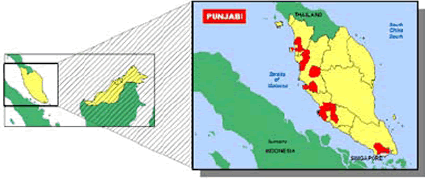The name Punjabi is used to describe both those who speak Punjabi and those who inhabit the Punjab region in India and Pakistan. There are approximately ninety thousand Punjabi in Malaysia. They first came to Malaysia in the 19th century as British political prisoners. A second wave was brought in by the British to serve as policemen for the British Straits Settlement communities and as night watchmen for industries.
Punjabi are a small minority among the approximately two million Indians in Malaysia. They have preserved a distinct Punjabi/Sikh identity within Malaysian society that sets them apart from the Tamil and other Indian communities that are Hindu. Malaysians commonly refer to the Punjabi community as Bengali, which is a misconception since they are from Punjab and not West Bengal. This misconception began because their Malaysian identification cards classify them as Bengali. Most people in Malaysia view the terms 'Punjabi' and 'Sikh' as synonymous. In reality, significant minorities of Punjabi people are Muslim and even smaller minorities are Hindu. Punjabi Muslims identify closely with other Indian Muslims as well as most of the Malay. Punjabi Hindus and Muslims commonly refer to themselves as Hindustani and Indian Muslim, respectfully. The Sikh see themselves as the only Punjabi that remain distinct from other groups in Malaysian society.
Many of the males are characterized by their long beards and neatly wound turbans. Many of the younger generation, however, can be found without beards or turbans. Another distinctive feature relates to food. If you catch the sight or scent of chapati (a traditional type of Punjabi bread) there is sure to be a Sikh nearby.
Subsequent generations of Punjabi in Malaysia realized the value of greater education and pursued occupations in professional fields such as medicine, law, teaching, and business. Some Sikhs are still visible as security guards and police officers. As the Punjabi in Malaysia become more educated and more integrated into modern Malaysian society, less emphasis is being place on the ability to read and write Punjabi. However, Punjabi people remain distinct from other people of Indian origins because of their religious beliefs and strong sense of community.
Punjabi are predominantly followers of the Sikh religion, though there are significant minorities of Muslim and Hindu among them. Sikhism is a monotheistic religion that was founded in northern India during the 16th century. Its teachings have combined elements of both Hinduism and Islam to find one god who transcends all religious distinctions. Sikhism stresses the importance of devotion, intense faith in the guru (teacher), the repetition of their god's name as a means of salvation or moksha (release into god's love), opposition to the worship of idols, the brotherhood of all men, and rejection of caste (pattern of social classes in Hinduism) system.
Punjabi Hindus and Muslims are often misunderstood and overlooked as distinct people groups among their larger religious and linguistic affiliations. Pray that Indian believers will help meet the needs of the Punjabi regardless of which religion they follow.
Pray the hearts of the Punjabi people in Malaysia would be stirred to hunger after God.
Pray that family-based movement to Christ will soon transform Punjabi society, blessing them spiritually and economically.
Pray for Punjabi decision makers to open their communities to Christ's ambassadors.
Scripture Prayers for the Punjabi in Malaysia.
Southeast Asia Link – SEALINK, Copyrighted © Used with permission
| Profile Source: Joshua Project |













